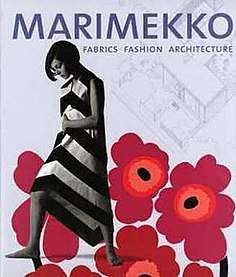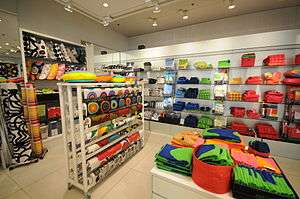Marimekko
|
Logo since 1954 | |
| Public (Nasdaq Helsinki: MMO1V) | |
| Industry |
Home furnishings Textiles Fashion |
| Founded |
25 May 1951 in Helsinki, Finland |
| Founder |
Viljo and Armi Ratia Riitta Immonen |
| Headquarters | Helsinki, Finland |
Key people |
Tiina Alahuhta-Kasko, CEO Mika Ihamuotila, Chairman Maija Isola, Designer Vuokko Nurmesniemi, Designer |
| Revenue |
|
|
| |
|
| |
Number of employees | 446 (31.12.2017)[1] |
| Website | marimekko.com |
Marimekko is a Finnish home furnishings, textiles, and fashion company based in Helsinki. It made important contributions to fashion in the 1960s. It is particularly noted for its brightly colored printed fabrics and simple styles, used both in women's garments and in home furnishings.
Two designers in particular, Vuokko Nurmesniemi, with bold stripes, and Maija Isola, with large simple flowered prints such as the Unikko poppy, created hundreds of distinctive patterns and helped to make Marimekko a household name across the world.
History
Foundation



Marimekko was founded in 1951 by Viljo and Armi Ratia, after the Viljo's oil-cloth factory project failed and was converted to a garment plant. Armi asked some artist friends to apply their graphic designs to textiles. To show how the fabric could be used, the company then designed and sold a line of simple dresses using their fabric. When Finland's leading industrial designer Timo Sarpaneva invited the company to present a fashion show (albeit canceled at short notice) at the 1957 Triennale in Milan, this was an early recognition of fashion as an industrial art and of Marimekko's key role in the process. The garments were eventually showcased in the nearby Rinascente upscale department store by display manager Giorgio Armani.[2]
Pioneering design
Two pioneering designers set the tone for Marimekko: Vuokko Nurmesniemi in the 1950s and Maija Isola in the 1960s.[3][4] Nurmesniemi designed the simply striped red and white Jokapoika shirt in 1956. Isola designed the iconic Unikko (poppy) print pattern in 1964.[5] Marimekko's bold fabrics and bright, simple design strongly influenced late 20th-century taste.[6] Many of the early Marimekko designs, including Isola's Unikko, remain in production in the 2010s.[7][8]
Commercial growth
Marimekko spread to America in the 1960s.[9] It was introduced to the United States by the architect Benjamin C. Thompson, who featured them in his Design Research stores. They were made famous in the United States by Jacqueline Kennedy, who bought eight Marimekko dresses which she wore throughout the 1960 United States presidential campaign.[10]
By 1965, the company employed over 400 staff, and the company was in every aspect of fine design, from fabrics to toys and dinnerware. The firm even completely equipped small houses with furnishings. In 1985, the company was sold to Amer-yhtymä. In the early 1990s, Marimekko was in a bad financial condition and close to bankruptcy. It was bought from Amer by Kirsti Paakkanen, who introduced new business methods in the company and helped to revive its popularity.[10]
Later in the 1990s Marimekko achieved publicity in the hit TV series Sex and the City. The fictional main character of the series, sex-and-relationship columnist Carrie Bradshaw, wore a Marimekko bikini on season 2 and then a Marimekko dress. In season 5 the series introduced tablecloths with Marimekko prints.[10]
In 2005, Marimekko's revenue had quadrupled since Paakkanen's purchase, and its net income had grown 200-fold. Paakkanen remained CEO of Marimekko and owned 20% of the company via her business Workidea. In 2007, Paakkanen announced she would gradually hand over her ownership to Mika Ihamuotila as CEO and biggest owner of the company. As of 2011, there are stores in New York City, Cambridge, Massachusetts; Oxford, Mississippi; Miami, Florida; and Vancouver, British Columbia.[11] By September 2011 there were 84 stores across the world.[10] Marikmekko products are (2017) made in China, India, Thailand and other countries. Fabrics are still printed in Marimekko's textile factory in Finland.[12]
Logo
The logo of Marimekko has been in use since 1954. Armi Ratia wanted the logo to be simple and timeless. Graphic designer Helge Mether-Borgström used modified versions of classic Olivetti typewriter letters to create the logo.[13]
Marimekko chart
The Marimekko name has been adopted within business and the management consultancy industry to refer to a specific type of bar chart known as a variable-width chart or Mosaic plot in which all the bars are of equal height, there are no spaces between the bars, and the bars are in turn each divided into segments of different width. The design of the mosaic plot resembles a Marimekko print.[14] The chart's design encodes two variables (such as percentage of sales and market share), but it is criticised for making the data hard to perceive and to compare visually.[15] The Marimekko has a sister chart called the Bar Mekko in which the bars are of variable height and width.[16]
Reception
Cindy Babski wrote in the New York Times that "There was never any doubt about what the inside label would say. The clothes and fabrics, with their striking design and splashes of bold color, were clearly Marimekko. But for people of a certain generation—those who came of age in the 1960's—they represented more than just a brand name: They conjured up an image and an era."[17]
In 2007, Heidi Avellan wrote in the Swedish newspaper Sydsvenskan that Marimekko was no longer a "statement, just as T-shirts with revolutionary Che Guevara or Palestinian scarves rarely express any political awareness. Marimekko is paper napkins and rubber boots". She wrote that Marimekko "began with the colourfully striped shirt, Jokapoika which Vuokko Nurmesniemi designed in 1956", which became the symbol for new radicalism in academia.[18]
Bibliography
- Aav, Marianne. Marimekko: Fabrics, Fashion, Architecture. Yale University Press, 2003. ISBN 978-0-300-10183-6
- Cole, Drusilla. The Pattern Sourcebook: A Century of Surface Design. Laurence King, 2009. ISBN 978-1-85669-621-0
- Fogg, Marnie. 1960s Fashion Print: A Sourcebook. Batsford, 2008. ISBN 978-0-7134-9054-1 (6 page-sized illustrations of Isola's prints) Google Books
- Isola, Kristina. Maija Isola: Life, Art, Marimekko. Design Museo, 2005. ISBN 978-952-9878-42-0
- Jackson, Lesley. Twentieth Century Pattern Design. Princeton Architectural Press, 2007. ISBN 978-1-56898-712-5
- Suhonen, Pekko. Phenomenon Marimekko. Marimekko Oy, 1986.
References
- 1 2 3 4 "Financial Statements Bulletin 2017" (PDF). Marimekko. Retrieved 2018-07-08.
- ↑ Kaj Kalin; Timo Sarpaneva; Marjatta Svennevig (1986). Sarpaneva. Helsinki: Otava. ISBN 951-1-07887-9.
- ↑ Kristina Isola, 2005
- ↑ Marnie Fogg, 2008
- ↑ Marimekko Timeline Archived 2011-10-27 at the Wayback Machine. Retrieved 30 October 2011
- ↑ Lesley Jackson, 2007
- ↑ Marimekko Products (in 2011) Archived 2011-10-09 at the Wayback Machine. Retrieved 30 October 2011
- ↑ "Marimekko - Finnish Design".
- ↑ Lange, Alexandra (23 June 2017). "Jane Jacobs, Georgia O'Keeffe, and the Power of the Marimekko Dress". The New Yorker.
- 1 2 3 4 Qureshi, Huma (20 September 2011). "The Guardian House and Home Blog". Marimekko's bid for world domination. The Guardian. Retrieved October 30, 2011.
- ↑ "Marimekko Shop Locator" Archived 2012-04-24 at the Wayback Machine. Retrieved 30 October 2011
- ↑ "Printed in Helsinki - About Marikmekko". Retrieved 28 August 2017.
- ↑ "History – Marimekko as a company". Marimekko. Retrieved 21 February 2018.
- ↑ "Mekkographics.com"
- ↑ "Example Marimekko Chart", Retrieved 30 October 2011
- ↑ "Mekkographics.com"
- ↑ Cindy Babski (January 3, 1988). "Marimekko Changes Its Spots". New York Times.
- ↑ HeidiAvellan (5 August 2007). "Radikala ränder (Radical stripes)". Sydsvenskan. Retrieved 5 October 2012.